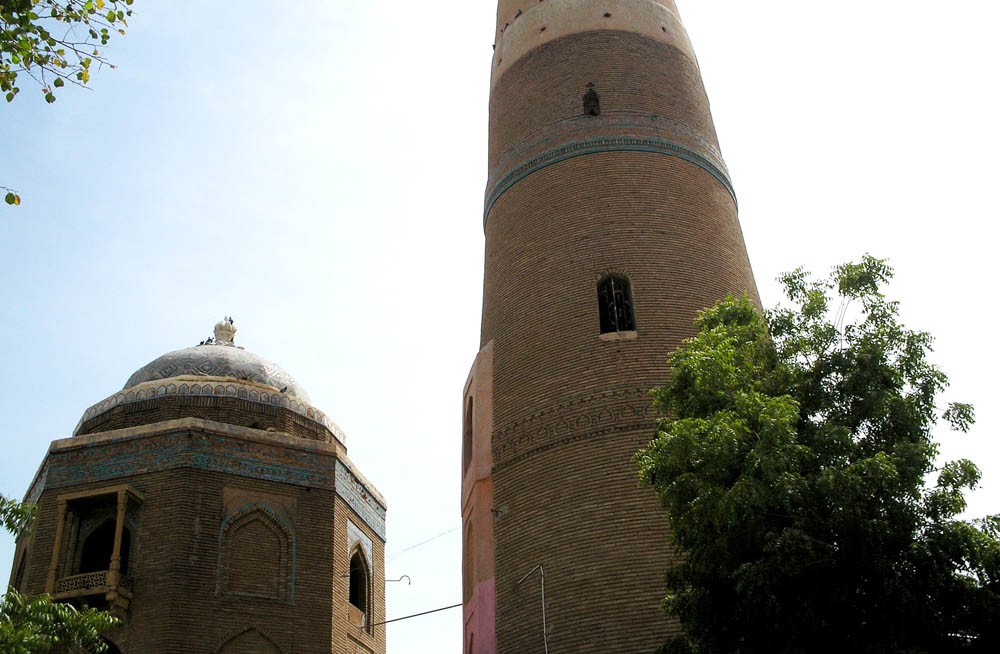
Exploring the charms of the historical city -- Sukkur Barrage, Masoom Shah Jo Minaro and Sadhu Bela temple

There are a few stories associated with the name of the city of Sukkur. Some believe that the word came from ‘shakkar’, meaning sugar, as there was cultivation of sugarcane in the surrounding region. Others believe that the city was named ‘sukh’, meaning comfort, as people were comfortable and content, with plenty to eat and enjoy.
It is the third largest city of Sindh, located on the west bank of the River Indus.
Just across the Indus is the town of Rohri, an important rail and road junction. Not too far from Sukkur is the date-producing Khairpur region, while Mohenjo-daro is only 100km away.
During our short stay in the city in late April, the temperature ranged between 42 to 47 degrees Celsius. And, this was only the onset of summer.
We went for a drive to see the famous Sukkur Barrage constructed in 1923 by the British. It was formerly called the Lloyd Bridge. The barrage is 5,000 feet long and is made of yellow stone and steel. After that we stopped at the Shahi Bazaar for some shopping: tie-and-dye dupattas, block-printed bed sheets and embroidered shirts.
Later, we went to see the famous Masoom Shah Jo Minaro, located closeby. It is an imposing tower but unfortunately all around it is commercial activity, with shops selling new plastic ware or old junk. One can only imagine how it might have stood proud and tall in the past in a vast open landscape.
The afternoon sun was intense, but we were asked to take off our slippers. We ran barefoot up the staircase, looking for a shaded place to stand. Two young men were sitting atop a parapet wall. I inquired if, like us, they too were visitors from another city. When they replied in the negative, I asked if there was any inscription or signboard where the history of the monument was written, or if they knew anything about the person whose tomb we were visiting. They had no idea.
I had known that Syed Mir Masoom Shah was the patron saint of the city but I later read that he was the governor of the area in the times of Emperor Akbar. The tower or minaret was built to keep a watch on the area. It was completed in 1617. Close to the tower is a pavilion made of sandstone which has the graves of Mir Masoom Shah and his family. Persian, written in relief, and other ornamental designs adorn the canopy and the stone pillars. There is also a small domed building, used as a resthouse.
Many other buildings in the city are attributed to the Mir Masoom Shah period.
The Jama Masjid in old Sukkur was built by Mir Safai, the father of Mir Masoom Shah.
"They built this high wall so people are safe when the water in the river rises. People were standing here to watch the flood," said the driver who was taking us around the city. He was referring to the Sukkur flood in September 2014 when water in the river had exceeded the danger level. Unfortunately, the beautiful view of the River Indus has been cut off by building this high wall for miles. I couldn’t help thinking that walls and barriers seem to have become a part of our psyche and the environment.
As we turned a corner, it was refreshing to see the River Indus through a fence, a pleasurable view of the water. A little earlier we had stood in the shade of trees on the banks of Lub-e-Mehran, a scenic riverbank site watching a donkey cart from which red carpets and bolster pillows were being loaded onto a boat, perhaps for a party across the river. Being complete strangers in the area, we had some fun taking turns to sit on the empty cart and posing for pictures.
We were keen to go to Sadhu Bela, the sprawling white-marble Hindu temple across the river, but we had to put it off for another visit. To compensate for this disappointment, our driver took us to a raised platform, a look-out point, from where we could view the venerated temple. Once again, braving the heat at 47 degrees, we stood for a long time, taking in the view.
The temple was established in 1823 by Baba Bankhandi Maharaj. According to legend, he came to this site when he was 15 years old, and died here at the age of 60. The temple, spread over nine acres on an island in the river, was constructed in 1889. A little ahead of the temple there is a Sikh gurdwara and the shrine of Khwaja Khizr, known as Zinda Pir, revered equally by Muslims and Hindus. The Hindus know him as Jind Pir -- an incarnation of the River Indus, also known elsewhere as Uderolal, Darya Shah, etc.
Besides enjoying the view of Sadhu Belo Island, we were impressed by the cantilevered Lansdowne Bridge, a 19th century engineering feat, and the longest ‘rigid girder’ bridge in the world at that time. Begun in 1887, it was designed by Sir Alexander Meadows Rendel. We also saw the railway bridge known as Ayub Bridge (named after former President Ayub Khan) that connects Sukkur with Rohri.
With these visions of Sufi saints, sadhus and bhakts, the blind Indus Dolphin and much else that remained hidden from my view on this visit, I promised myself to make another trip to this area -- the cradle to one of the world’s earliest civilisations.